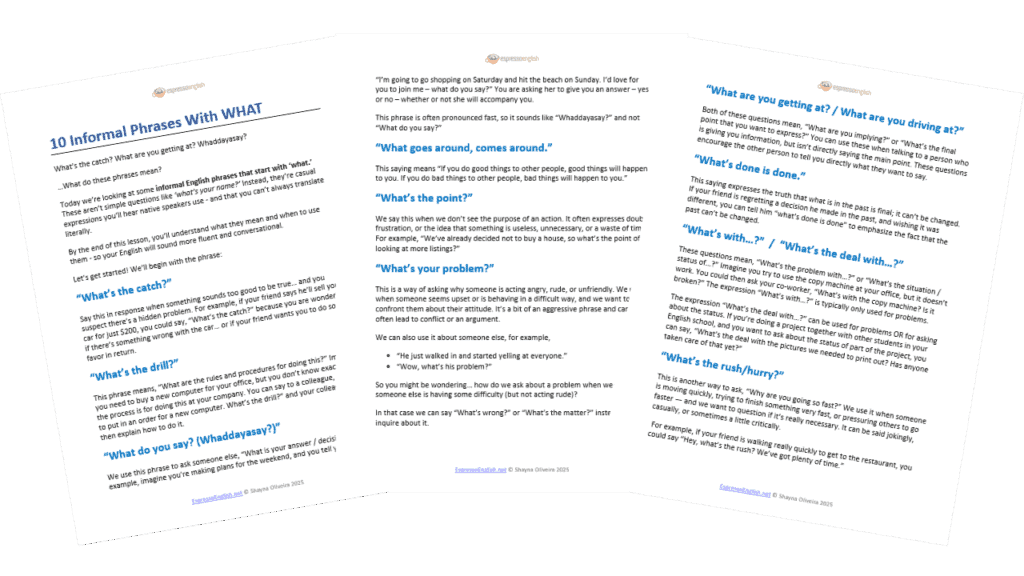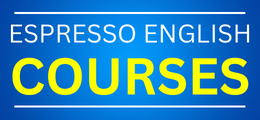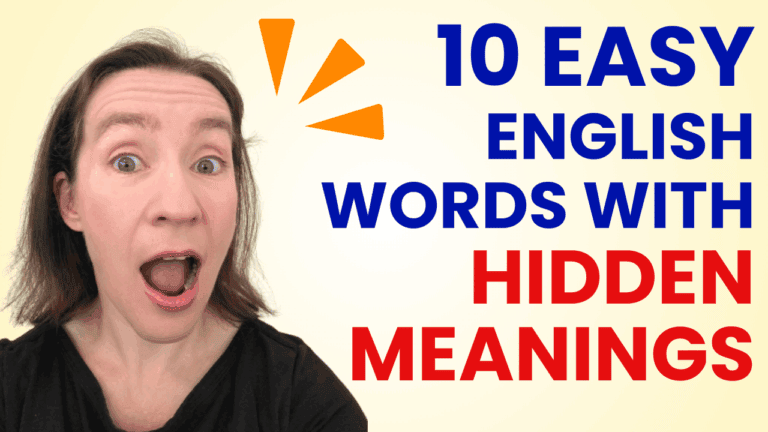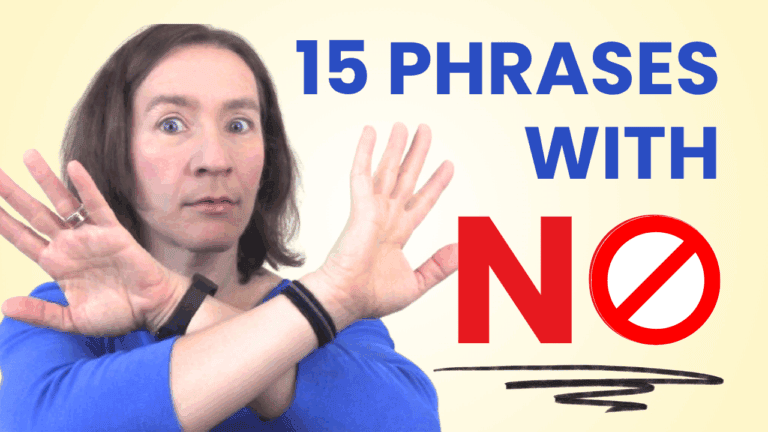
Everyday English Speaking Course
What’s the catch? What are you getting at? Whaddayasay?
… what on earth do these phrases mean???
Today we’re looking at some informal English phrases that start with “what.” These aren’t simple questions like “What’s your name?” — instead, they’re casual expressions you’ll hear native speakers use – and that you can’t always translate literally.
By the end of this lesson, you’ll understand what they mean and when to use them – so your English will sound more fluent and conversational. Let’s get started!
Make sure to download the free PDF of today’s lesson. Enter your e-mail address, and I’ll send you that PDF right away so you can remember and review what you’re learning.
We’ll begin with the phrase:
“What’s the catch?”
Say this in response when something sounds too good to be true… and you suspect there’s a hidden problem. For example, if your friend says he’ll sell you his car for just $200, you could say, “What’s the catch?” because you are wondering if there’s something wrong with the car… or if your friend wants you to do some favor in return.
“What’s the drill?”
This phrase means, “What are the rules and procedures for doing this?” Imagine you need to buy a new computer for your office, but you don’t know exactly what the process is for doing this at your company. You can say to a colleague, “I need to put in an order for a new computer. What’s the drill?” and your colleague can then explain how to do it.
“What do you say? (Whaddayasay?)”
We use this phrase to ask someone else, “What is your answer / decision?” For example, imagine you’re making plans for the weekend, and you tell your friend, “I’m going to go shopping on Saturday and hit the beach on Sunday. I’d love for you to join me – what do you say?” You are asking her to give you an answer – yes or no – whether or not she will accompany you. This phrase is often pronounced fast, so it sounds like “Whaddayasay?” and not “What do you say?”
“What goes around, comes around.”
This saying means “If you do good things to other people, good things will happen to you. If you do bad things to other people, bad things will happen to you.”
“What’s the point?”
We say this when we don’t see the purpose of an action. It often expresses doubt, frustration, or the idea that something is useless, unnecessary, or a waste of time. For example, “We’ve already decided not to buy a house, so what’s the point of looking at more listings?”
“What’s your problem?”
This is a way of asking why someone is acting angry, rude, or unfriendly. We use it when someone seems upset or is behaving in a difficult way, and we want to confront them about their attitude. It’s a bit of an aggressive phrase and can often lead to conflict or an argument.
We can also use it about someone else, for example,
- “He just walked in and started yelling at everyone.”
“Wow, what’s his problem?”
So you might be wondering, how do we ask about a problem when we see that someone else is having some difficulty (but not acting rude)? In that case we can ask one of these questions instead:
- “What’s wrong?”
- “What’s the matter?”
“What are you getting at? / What are you driving at?”
Both of these questions mean, “What are you implying?” or “What’s the final point that you want to express?” You can use these when talking to a person who is giving you information, but isn’t directly saying the main point. These questions encourage the other person to tell you directly what they want to say.
“What’s done is done.”
This saying expresses the truth that what is in the past is final; it can’t be changed. If your friend is regretting a decision he made in the past, and wishing it was different, you can tell him “what’s done is done” to emphasize the fact that the past can’t be changed.
“What’s with…?” / “What’s the deal with…?”
These questions mean, “What’s the problem with…?” or “What’s the situation / status of…?”
Imagine you try to use the copy machine at your office, but it doesn’t work. You could then ask your co-worker, “What’s with the copy machine? Is it broken?” The expression “What’s with…?” is typically only used for problems.
The expression “What’s the deal with…?” can be used for problems OR for asking about the status. If you’re doing a project together with other students in your English school, and you want to ask about the status of part of the project, you can say, “What’s the deal with the pictures we needed to print out? Has anyone taken care of that yet?”
“What’s the rush/hurry?”
This is another way to ask, “Why are you going so fast?” We use it when someone is moving quickly, trying to finish something very fast, or pressuring others to go faster — and we want to question if it’s really necessary. It can be said jokingly, casually, or sometimes a little critically. For example, if your friend is walking really quickly to get to the restaurant, you could say “Hey, what’s the rush? We’ve got plenty of time.”
Great job — now you know a bunch of informal English phrases with “what” that native speakers use in everyday life. These little expressions are what help make your English sound natural and fluent, instead of like a textbook.
If you enjoyed this lesson and you want to keep learning the kinds of phrases native speakers really use in daily life, check out my Everyday English Speaking Courses. They’re full of practical lessons, dialogues, and practice activities that will help you feel confident in real conversations. I’ll put the link in the video description so you can learn more and sign up.









